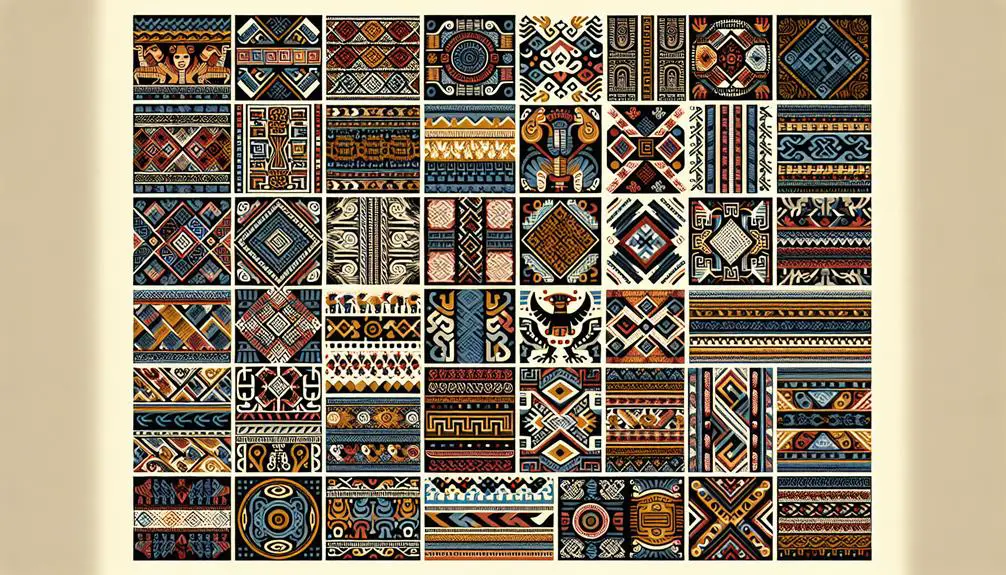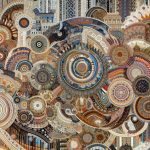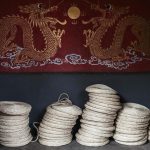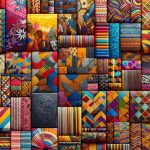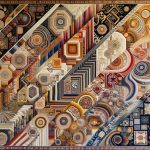When you explore the evolution of textile patterns, you uncover a rich tapestry of cultural heritage and artistic ingenuity. Imagine the ancient Chinese brocades, their vibrant colors and intricate designs symbolizing power and prosperity. Or picture the timeless Persian paisleys, each swirl a tribute to centuries of craftsmanship and storytelling. These aren't just decorative elements; they're visual narratives preserving traditions and beliefs. Curious about how Egyptian motifs reflect profound cultural symbolism or how medieval European tapestries chronicle history? There's a fascinating journey through time and artistry waiting to be uncovered.
Table of Contents
Key Takeaways
- Ancient Chinese brocades feature intricate designs and vibrant colors, originating from sericulture and used in imperial clothing to convey power and prosperity.
- Persian paisleys are known for their elaborate, swirling floral motifs that tell stories and showcase the skill of Persian weavers.
- Egyptian motifs include symbols like the scarab beetle, ankh, and lotus flower, reflecting profound religious beliefs and artistic influences.
- Aztec geometric designs use bold patterns and vibrant colors to symbolize natural elements and convey stories through repetition and symmetry.
- Medieval European tapestries are storytelling canvases made from wool, silk, and gold threads, depicting historical and cultural themes with intricate craftsmanship.
Ancient Chinese Brocades
Ancient Chinese brocades, with their intricate designs and vibrant colors, showcase the remarkable craftsmanship and cultural significance of early textile art. When you explore these luxurious weaves, you're examining a tradition that dates back thousands of years. The origins of silk in China are legendary, often credited to the mythical Empress Leizu, who's said to have discovered sericulture. This discovery led to the creation of brocades that weren't only beautiful but also incredibly durable and luxurious.
As you inspect these ancient textiles, you'll notice the tremendous skill involved in their creation. Each piece was meticulously woven, often reserved for imperial clothing. The elaborate patterns you see are a tribute to the weavers' mastery. Dragons, phoenixes, and other auspicious symbols were commonly used, reflecting the high status and cultural importance of the wearer. These motifs weren't just decorative; they conveyed messages of power, prosperity, and divine favor.
Persian Paisleys
When you explore Persian swirls, you're delving into a rich tapestry of history and artistry that has influenced textile patterns worldwide. Persian swirls, known for their elaborate patterns and vibrant colors, are a tribute to the region's mastery of complex weaving techniques. Originating in Persia, these designs have a historical importance that spans centuries, reflecting the cultural and artistic heritage of the region.
Imagine the lush gardens, the swirling floral motifs, and the deep, vivid hues. Persian swirls are not just patterns; they're stories woven into fabric. Each curve and swirl of the paisley motif is a nod to the past, yet remains timeless in its appeal. The craftsmanship involved in creating these textiles is awe-inspiring, showcasing the skill and dedication of Persian weavers.
Here's a glimpse into what makes Persian swirls so enchanting:
| Element | Emotion Evoked | Example |
|---|---|---|
| Elaborate Patterns | Awe | Detailed paisley motifs |
| Vibrant Colors | Excitement | Rich blues and golds |
| Historical Importance | Reverence | Centuries-old designs |
Egyptian Motifs
Egyptian motifs captivate with their intricate symbols and deep connections to the civilization's rich mythology. You can see the symbolic meanings and intricate details of these designs in everything from the iconic scarabs to the revered ankh. Each motif tells a story, reflecting the Egyptians' profound beliefs and the artistic influences that have left an indelible mark on textile patterns.
To help you appreciate their beauty and historical significance, consider these key elements often found in Egyptian motifs:
- Scarab Beetles: Representing rebirth and protection, these beetles are omnipresent in Egyptian art and textiles.
- Ankh: Symbolizing eternal life, the ankh is a powerful emblem seen in countless fabric designs.
- Lotus Flowers: Signifying creation and regeneration, the lotus is a common motif with deep spiritual symbolism.
- Hieroglyphs: These intricate symbols convey complex messages and add a layer of mystique to textile patterns.
Aztec Geometric Designs
Much like Egyptian motifs, Aztec geometric designs captivate with their bold patterns and profound cultural symbolism. You'll find that Aztec influence is unmistakable in the intricate symmetry and vibrant colors that define these textiles.
Each shape and line isn't just decorative; it's a visual language that conveys stories, beliefs, and a deep connection to nature and the cosmos.
To master the geometric interpretation of Aztec designs, you need to appreciate the precision and meaning behind each element. Triangles, circles, and squares often represent natural elements like mountains, the sun, and the earth.
The repetition and symmetry in these patterns aren't arbitrary; they symbolize harmony and balance within the universe.
When studying these textiles, focus on the interplay of colors and shapes. The Aztecs utilized a vivid palette, rich in reds, blues, and yellows, to enhance the visual impact of their designs.
Medieval European Tapestries
Medieval European tapestries weave a rich narrative of history, culture, and artistry through their intricate designs and detailed craftsmanship. You'll find that these tapestries were more than just decorative pieces; they were storytelling canvases that chronicled significant events, legendary tales, and everyday life.
Mastering medieval tapestry techniques meant understanding their historical significance, as artisans employed complex weaving methods to produce these masterpieces.
To appreciate these works, consider these key elements:
- Materials: Wool, silk, and gold threads were commonly used, reflecting the status and wealth of the owner.
- Techniques: The use of the high-warp (haute-lisse) and low-warp (basse-lisse) looms were essential in defining the texture and detail of the tapestries.
- Themes: Biblical stories, mythological scenes, and hunting expeditions were popular subjects, showcasing the artistic interpretations of the time.
- Evolution: European textile evolution is evident as you trace the shift from Romanesque to Gothic styles, reflecting broader cultural and artistic trends.
Indonesian Batiks
You're about to explore the intricate world of Indonesian Batiks, where traditional craft techniques bring fabric to life.
You'll discover how these patterns aren't just decorative but also rich in cultural symbolism.
Let's uncover the unique methods and meanings behind this timeless textile art.
Traditional Craft Techniques
Explore the intricate world of Indonesian Batiks, where artisans skillfully wax and dye fabrics to create stunning patterns. As you investigate into this traditional craft, you'll discover techniques that have been perfected over centuries.
Unlike loom weaving, which relies on interlacing threads, Batik involves applying wax to fabric in detailed designs before immersing it in natural dyes. This method allows for unparalleled precision and vibrant colors.
Mastering Batik requires understanding several key steps:
- Wax Application: Using tools like the canting or a copper stamp, you apply hot wax to the fabric, creating intricate patterns.
- Dyeing: Submerge the waxed fabric in dye, where the un-waxed areas absorb the color.
- Wax Removal: Boil the fabric to remove the wax, revealing the detailed design.
- Repetition: Repeat the process for multiple colors, layering wax and dye to achieve complex patterns.
Beyond wax and dye, Batik artisans often incorporate embroidery techniques to embellish their handcrafted textiles, adding another dimension of artistry.
Your journey into Indonesian Batiks will enhance your appreciation for these timeless skills, offering a deeper understanding of traditional craft techniques that continue to enchant and inspire.
Cultural Symbolism Explained
Indonesian Batiks often carry deep cultural symbolism, with each pattern telling a unique story about the region's history and beliefs. As you explore these intricate designs, you'll find that color psychology plays a significant role. For instance, certain hues are tied to specific meanings and occasions. Red symbolizes bravery, while blue represents calm and peace. These colors aren't just aesthetic choices—they're deeply embedded in the cultural significance of each piece.
To better understand the textile artistry and historical context behind Indonesian Batiks, consider the following table:
| Pattern | Meaning | Typical Colors |
|---|---|---|
| Parang | Power and Authority | Earth tones, Red |
| Kawung | Purity and Justice | White, Black |
| Mega Mendung | Calmness and Serenity | Blue, Grey |
Each of these patterns has been meticulously crafted, reflecting centuries of tradition and artistry. The Parang pattern, for example, was historically worn by royalty, symbolizing power and authority. Meanwhile, the Kawung pattern is one of the oldest, symbolizing purity and justice.
Modern Textile Innovations
You'll be amazed by how modern textile innovations are transforming the industry.
From sustainable fabric technologies to smart textiles, the advancements are impressive.
Let's explore how these cutting-edge developments are shaping the future of textiles.
Sustainable Fabric Technologies
With the increasing demand for eco-friendly products, sustainable fabric technologies have revolutionized the textile industry. You're now seeing innovative approaches that minimize environmental impact while maintaining high-quality standards.
Two key advancements include eco-friendly dyeing and the use of renewable fibers.
Eco-friendly dyeing processes reduce the ecological footprint by using natural dyes and low-water techniques. These methods not only conserve water but also eliminate harmful chemicals, ensuring safer products for both you and the environment.
Renewable fibers, like organic cotton, bamboo, and hemp, are sourced from plants that can be regrown, providing a sustainable alternative to traditional materials.
To achieve mastery in understanding sustainable fabric technologies, consider these four innovations:
- Waterless Dyeing: Techniques like supercritical CO2 dyeing drastically cut down water usage.
- Biodegradable Fibers: Fibers that break down naturally after disposal, reducing landfill waste.
- Recycled Materials: Fabrics made from recycled plastics or old garments, promoting circular fashion.
- Low-impact Processing: Techniques that use less energy and fewer resources throughout the production cycle.
Smart Textiles Integration
Building on the momentum of sustainable fabric technologies, smart textiles are pushing the boundaries of innovation by integrating technology directly into fabrics. Imagine your clothing acting as both a fashion statement and a high-tech device. With wearable technology, you can monitor your heart rate, track fitness levels, or even answer a phone call through your shirt sleeve. These advancements aren't just fanciful ideas but real, tangible products revolutionizing how you interact with your garments.
Interactive fabrics are the key players in this transformation. These textiles can sense and react to environmental stimuli, creating a dynamic relationship between you and your outfit. For instance, heated jackets that adjust to your body temperature or fabrics that change color based on your mood are no longer science fiction. They're here, and they're changing the game.
To master the potential of smart textiles, you'll need to stay ahead of the curve. Understanding how conductive threads, micro sensors, and flexible electronics work will put you at the forefront of this burgeoning industry. Embrace the future where your clothing isn't just worn but experienced, blending the world of fashion and technology seamlessly.
Frequently Asked Questions
How Are Textile Patterns Preserved in Museums?
To master textile pattern conservation, you'll need to understand preservation techniques like controlling temperature, humidity, and light exposure. Museums use specialized display strategies, ensuring patterns remain vibrant and intact for future generations to admire.
What Role Do Textile Patterns Play in Modern Fashion?
Textile patterns in modern fashion reflect cultural influences and shape fashion trends. You can see artistic expression in unique designs, while marketing strategies leverage these patterns to captivate consumers and drive brand loyalty.
How Do Textile Patterns Influence Interior Design Trends?
Textile patterns shape interior design trends by blending cultural influence and historical significance. You'll see how these patterns add depth, evoke emotions, and create harmonious spaces, reflecting both tradition and contemporary aesthetics in your home.
What Techniques Are Used to Digitally Recreate Historical Textile Patterns?
You'll use digital tools combined with traditional techniques to digitally recreate historical textile patterns. Balancing historical accuracy and creative interpretation guarantees your designs are authentic yet innovative, meeting the high standards of those seeking mastery.
How Do Artisans Choose Colors for Traditional Textile Patterns?
You're diving into a world of infinite color choices! Artisans select hues based on color symbolism and cultural significance, ensuring each shade resonates deeply with tradition and heritage, creating patterns that are truly masterpieces of cultural storytelling.
- The Ultimate Guide to Mulberry Home Upholstery Fabric - June 21, 2025
- How to Care For Mulberry Silk Fabric to Make It Last a Lifetime - June 21, 2025
- A Guide to Mulberry Home Fabrics: Exploring Iconic Designs & Collections - June 21, 2025

